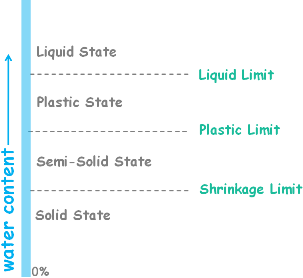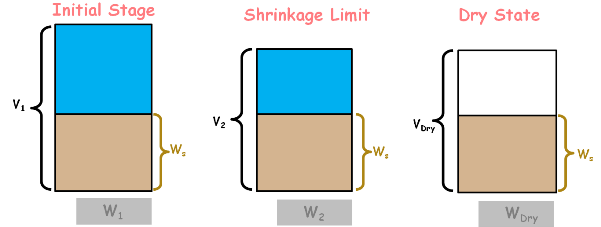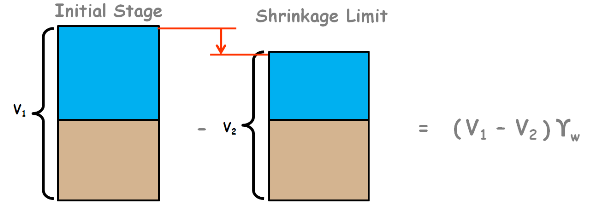 Consistency is a term which is used to describe the degree of firmness of soil. It is indicated by terms such as soft, medium and hard. Depending upon the water content soil may appear in one of these four states.
Consistency is a term which is used to describe the degree of firmness of soil. It is indicated by terms such as soft, medium and hard. Depending upon the water content soil may appear in one of these four states.
Liquid State
Plastic State
Semi Solid State and
Solid State
Consistency limits are water content at which the soil changes from one of these states to another. These limits are:
Liquid Limit
Plastic Limit
Shrinkage Limit
In liquid state water content of the soil is such that it behaves like liquid and offers no resistance to flow.
When water content of this soil drops it gains shear strength and develops resistance to flow. After reaching certain water content named as liquid limit soil enters into a state called plastic state of soil.
In plastic state soil can be moulded in any shape due to a property called plasticity.
When water content of the soil is further reduced, after reaching another certain water content named as Plastic limit, soil enters into another state called semi solid state.

In semi-solid state the fine grained soil is harder than being in the plastic state, but it is softer than that of being in the solid state. In semi-solid state soil loses its plasticity. We will come to know that soil has reached the semi solid state when it begins to crumble when rolled into threads of 3 mm diameter.

From liquid state to semi-solid state, soil remains fully saturated and with the reduction in water content volume of the soil mass reduces almost in equal amounts till a stage is reached when further reduction of the water content does not cause any reduction in the volume of the soil.
 At that point soil mass changes from semi solid state to solid state. Soil converts into a soil mass which has developed pores into it and that are partially filled with water. Now if we dry the soil to reduce its water content, soil’s volume remains the same but its pore water gets reduced. Hence no volume changes with water content reduction. That the soil does not shrink any more.
At that point soil mass changes from semi solid state to solid state. Soil converts into a soil mass which has developed pores into it and that are partially filled with water. Now if we dry the soil to reduce its water content, soil’s volume remains the same but its pore water gets reduced. Hence no volume changes with water content reduction. That the soil does not shrink any more.
When water content of a soil is reduced and at particular water content soil stops shrinking, that water content is called shrinkage limit of that soil.
Shrinkage limit can also be defined as the lowest water content at which soil is fully saturated because if we reduce the water content below this limit soil begins to dry up at the surface. The colour of the sample also begins to change. Air enters the void of the soil and soil is no longer fully saturated.
Shrinkage Limit Determination
 For the determination of shrinkage limit the soil is air dried and sieved through 425 micron IS sieve to get fine grained soil only. Because we know Atterberg limits are only significant for the fine grained soils. 425 micron IS sieve has its mesh openings of 425 micron or 0.425 mm. The particles we get after sieving are all of the size less than 425 micron. These particles include fine sand, silts and clays.
For the determination of shrinkage limit the soil is air dried and sieved through 425 micron IS sieve to get fine grained soil only. Because we know Atterberg limits are only significant for the fine grained soils. 425 micron IS sieve has its mesh openings of 425 micron or 0.425 mm. The particles we get after sieving are all of the size less than 425 micron. These particles include fine sand, silts and clays.
We take about 30 gm of this sieved soil in an evaporating dish. The soil is mixed with sufficient quantity of water to bring it to a consistency that it may flow.

A circular shrinkage dish made of steel is taken. Its empty weight is noted down as WDish.
 To determine its volume it is filled with mercury. Excess mercury is removed by pressing a glass plate over the top of the dish. Weight of this mercury is taken and noted down as Wmercury.
To determine its volume it is filled with mercury. Excess mercury is removed by pressing a glass plate over the top of the dish. Weight of this mercury is taken and noted down as Wmercury.
From this weight of mercury its volume can be determined as weight of mercury divided by specific gravity of the mercury.

How did we get this?? Well we know specific gravity of any substance is unit weight of that substance divided by unit weight of water.

Unit weight of water is considered as 1g/cc and unit weight of mercury is taken as 13.6.
Volume of our shrinkage dish will be equal to the volume of this mercury.
VDish = Vmercury
Then inside of the dish is coated with a thin layer of Vaseline so that soil pat can be removed easily once it is dried. Our prepared soil sample is placed in the dish in three layers by continually tapping the dish on the hard surface so as to ensure the removal of any entrapped air. After completely filling the dish excess soil is removed and weight of the dish is taken. By removing the weight of dish only weight of soil pat is noted down as W1.
Also the volume of this soil is noted down as V1 and this is equal to the volume of empty dish we determined.

We can represent this flowing state of soil sample using the phase diagram. V1 is the total volume of this soil and weight of this sample is W1. We also represent weight of solids as Ws.
If the soil is allowed to dry up gradually up to its shrinkage limit, where soil is still fully saturated and all the soil pores are filled with water then we can show that stage with the second figure in the image kind of block diagram. Here volume of this soil sample is considered as reduced to V2 from initial state of V1 and weight of this sample as W2 from W1.

Now the soil pat in the dish is allowed to dry in the air till the color of the soil pat changes from dark to light. Then the dish is dried in the oven at 110 degree centigrade. Soil’s pores water reduced to zero and now pores are only filled with air.
Weight of this dried soil is taken by removing weight of dish and noted down as Wdry. This dry weight of soil is actually equal to the weight of solids as soil mass contains only solids and air.

The third block diagram represents that completely dry state of soil. Here volume of the soil remains the same as it was at shrinkage limit. We can write this dry soil volume as Vdry and its weight can be written as Wdry.
Here we already know Wdry but Vdry is unknown. The volume of the dry pat of soil is measured by the mercury displacement method.
For that we take a glass container and fill it completely with mercury. We place this container in a pan. Excess mercury is removed by pressing a glass plate over the top of the container. Any mercury adhered to the side of the container is wiped off.

Now the dry soil pat is removed from the shrinkage dish and placed on the top of the mercury surface. It is then submerged into the mercury by again pressing a glass plate over the top of the container. Mercury displaced is collected and weighed. Its volume is determined from its weight and specific gravity. The volume of this displaced mercury will be equal to the volume of our dried soil pat (Vdry).

Let’s say the volume of solids present as Vs which is actually the same in any state of the soil at different water contents.
Now consider all the phase diagrams of the soil in different stages.

In all the states weight of solids are constant.
Weight of water in the initial state when we mixed the water into the sieved soil will be equal to the weight of initial soil sample minus weight of dry soil sample. That is:

 Now this much amount of water (shown in the figure) the soil has to lose to reach at the shrinkage limit and that will be equal to the V1 minus V2.
Now this much amount of water (shown in the figure) the soil has to lose to reach at the shrinkage limit and that will be equal to the V1 minus V2.
This is only volume difference of these two states. To get the weight of water we need to multiply this by unit weight of water, i.e. Yw(V1 – V2)
Hence from these two determined values we can calculate the amount of water present in the soil sample at its shrinkage limit by weight of water in the soil at initial stage minus weight of water needed to lose to reach shrinkage limit
![]()
We know that shrinkage limit is nothing but the water content value and water content is defined as the weight of water present in the soil divided by weight of solids presents.

We now have weight of water in soil at shrinkage limit and we know weight of solids is same in all the states. Which is Wdry.

If we separate these two

we can see this quantity is water content of the soil at its initial stage when it was initially taken. Which can be written as Wi for water content initial. Also volume of sample V2 at shrinkage limit is equal to the volume the sample at dry state so this can be written as Vd.

Using this equation shrinkage limit of any soil can be calculated.
In this equation all the quantities are known to us
Wi is water content of the soil at initial saturated condition which may be determined by any of the water content determination methods.
V1 is volume of the soil at initial saturated condition
Vd is dry volume of the soil sample
WDry is dry weight of the soil sample
And YW is unit weight of water.






